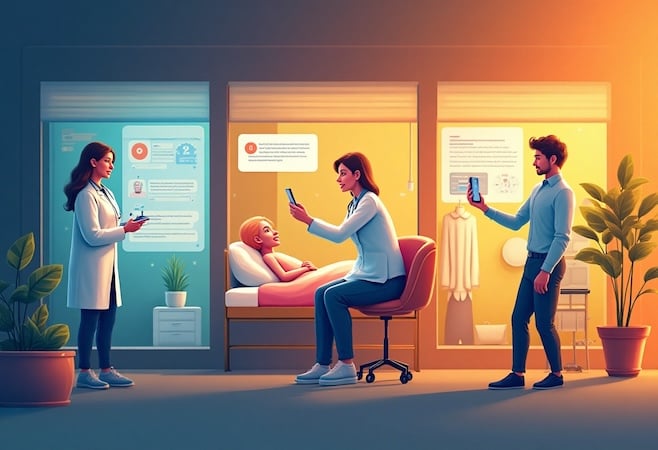Let’s be real: healthcare AI compliance is where ambitious ideas go to die — or at least get buried in red tape. You’ve got generative AI features your users will love, a roadmap that makes your investors drool… and then legal sends you a Google Doc titled “HIPAA Considerations: V34.”
Sound familiar?
But here’s the thing: compliance doesn’t have to kill momentum. When done right, AI can automate the mind-numbing parts of compliance — audit trails, redactions, PHI monitoring — and actually become your safety net, not your bottleneck.
In this blog, we’ll cut through the noise and show you how smart teams are using AI to streamline compliance, reduce risk, and ship faster — without waking up to an OCR nightmare.
Key Takeaways
- AI for regulatory healthcare compliance isn’t just a checkbox — it’s the operational backbone smart healthtech teams use to reduce risk, eliminate manual audits, and ship faster.
- Real-world use cases of artificial intelligence healthcare compliance already include PHI redaction, billing code validation, RAG-powered chatbots, and predictive audit tools — and they’re working today, not in some theoretical future.
- The biggest compliance risks with AI? Invisible bias, unexplainable decision logic, and weak vendor governance. Solving these early means fewer lawsuits — and faster growth.
Table of Contents
- Why AI in Healthcare Compliance Can’t Wait Any Longer
- How AI-Powered Compliance Is Fixing Healthcare’s Weakest Link
- Real-World Applications of AI Compliance in Healthcare
- Navigating the Risks: Ethical & Regulatory Challenges in AI-Driven Healthcare Compliance
- Where AI-Driven Compliance in Healthcare Is Headed Next
- Why Topflight Is Your Partner for AI-Powered Healthcare Compliance
Why AI in Healthcare Compliance Can’t Wait Any Longer
If your compliance playbook still relies on a checklist in SharePoint and someone named Karen triple-checking CSVs, you’re already behind. AI in healthcare compliance isn’t some bleeding-edge fantasy — it’s quietly becoming the baseline for anyone serious about scaling without flirting with million-dollar fines.
The Real Risk Isn’t Just Regulatory — It’s Operational Paralysis
In most healthcare orgs we audit, compliance is duct-taped to the side of the operations platform as an afterthought. That’s why:
- You’re burning cycles chasing down missing audit trails
- Your engineers keep rebuilding the same PHI redaction logic
- And your legal team is holding up product releases like it’s their side gig
Let’s be blunt: manual compliance checks don’t scale — especially in a healthcare system where everything moves faster than your approval process. AI systems can:
- Flag non-compliant data flows before they hit prod
- Auto-document what your team would otherwise forget
- Assist in decision making without introducing human inconsistency
And yes — compliance done right directly impacts patient care. The fewer errors, the less risk, the faster patients get what they need.
One More Thing: ChatGPT Isn’t Automatically HIPAA-Compliant
We’ve seen teams try to shortcut workflows with LLMs, only to realize too late they’ve violated their BAA. Read this before you plug anything in: ChatGPT HIPAA compliance.
You Need More Than Code — You Need Process
We’ve built enough AI-first health apps to know it’s not just about tools — it’s about building a repeatable system. Start here: HIPAA compliant software development. Or don’t, and keep paying for it in audits.
How AI-Powered Compliance Is Fixing Healthcare’s Weakest Link
Most healthcare organizations treat compliance like a post-facto checklist: handle the build first, then bolt on a “HIPAA filter.” And that’s why their ops crawl the minute audits hit. The smarter teams are flipping the script — baking AI into the workflow to catch issues before they go live.
Let’s break down how AI for regulatory healthcare compliance is quietly becoming the backbone of smart product ops:
Real-Time Privacy Alerts: Stop Breaches Before They Cost You
Vendors like Verisys are already deploying AI tools that monitor access to patient data in real time — flagging suspicious logins or off-hours browsing behavior. That’s not a theory; that’s happening in live environments today. The result? Fewer HIPAA violations, faster response times, and a lot less CYA scrambling.
Audit Trail Analysis: Because Manual Log Reviews Are a Joke
You know those EMRs spitting out access logs? AI systems like Simbo AI analyze those logs to highlight anomalies or access patterns that scream “non-compliance.” It’s like having a junior auditor who never sleeps, surgically scanning every access record for risk — and feeding insights back into your policy loop.
Billing Code Validation: Cut the Denials, Not Corners
CureMD’s AI-assisted billing platform claims 100% coding compliance — and while I don’t buy that number, they’re not far off. Using NLP, AI reviews clinical notes and auto-suggests proper billing codes, slashing denials and elevating care delivery by cutting down on the back-and-forth with payers.
Risk Scoring: Proactive, Not Reactive
Companies like Raapid are using AI based systems (trained on millions of charts) to assign compliance risk scores. These aren’t glorified spreadsheets — they’re pulling data from provider notes, validating them with MEAT (Monitor, Evaluate, Assess, Treat), and surfacing what CMS will probably flag before your auditors do.
This isn’t theory anymore — it’s a working platform accelerate model for teams that know HIPAA compliant app development isn’t just a checkbox.
Wondering how will AI help change EHR systems? Start here: these tools don’t just plug into the EHR — they reshape workflows around precision and traceability.
Real-World Applications of AI Compliance in Healthcare
Let’s skip the AI theater and get to what’s actually live in the field. The best healthcare AI compliance stories aren’t the ones buried in whitepapers — they’re happening in hospitals and healthtech startups quietly using AI to avoid audit disasters, fix broken ops, and get paid faster.
Case Review Overhaul: Valley Medical Center x Xsolis
Most hospitals screw up patient status determinations — and CMS notices. Valley Medical Center deployed Xsolis’s Dragonfly Utilize platform to align observation rates with federal benchmarks. It’s not just an analytics toy:
- Case review volume jumped from 60% to 100%
- Extended observation rates dropped from 36.2% to 27.3%
- CMS alignment improved from 4% to ~13% (CMS alignment = proportion of observation cases matching CMS benchmarks)
Translation? Better documentation, fewer payer disputes, and way more breathing room for clinical teams. This is how AI improves healthcare operations while keeping finance and compliance from killing each other.
Billing Accuracy at Scale: Lone Star Circle of Care x XpertDox
AI in medical billing and coding isn’t about automation — it’s about precision under pressure. Lone Star partnered with XpertDox to cut down charge-entry lag and clean up medicare billing compliance. Their AI technologies handle Category II CPT codes, payer-specific rules, and auto-generate audit trails — all inside a HIPAA envelope. No flashy dashboard, just solid RCM execution.
PHI Redaction & NLP Summaries: Speed Meets Safety
Startups like Redactor.ai and Strac are doing the unsexy but essential work of real-time PHI redaction across platforms like Slack and Zendesk — making sure your help desk doesn’t become a HIPAA liability. Meanwhile, tools like Hathr AI and CompliantChatGPT are tackling conversational AI in healthcare workflows: SOAP notes, bloodwork insights, and summarization. All wrapped in encryption and BAA-ready compliance.
What This Means for Clinical Teams
Here’s the kicker: these tools aren’t just compliance insurance. They free up time for clinical care, reduce burnout, and allow actual humans to focus on what matters — not babysitting logs.
If your team’s drowning in health data and your engineers are building the tenth “HIPAA-ready” redaction script from scratch, it’s time to rethink. Done right, AI maintains compliance and improves the care experience.
Navigating the Risks: Ethical & Regulatory Challenges in AI-Driven Healthcare Compliance
If you’re building artificial intelligence healthcare compliance into your platform without reading the latest HHS and FDA memos, you’re not just guessing — you’re begging for an investigation.
Let’s get one thing straight: the feds are no longer in “watch and wait” mode. From OCR’s non-discrimination enforcement under Section 1557 to the FDA’s lifecycle oversight for AI-enabled medical devices, the compliance bar just got higher — and it’s moving fast.
Red Flag #1: AI That Discriminates
The regulatory challenges aren’t just technical — they’re ethical, and they’re legally enforceable. OCR has made it clear: if your AI system under-refers Black patients to specialists, or triages disabled patients inaccurately, you’re violating civil rights law. Full stop.
What to do:
- Demand transparency from your AI vendors: what variables are driving outputs?
- Implement bias audits pre-deployment (and post).
- Keep a human in the loop — and be able to override.
Red Flag #2: The “Explainability” Black Hole
Your AI model may be brilliant. But if no one can explain why it made a clinical decision, that’s a compliance nightmare. Regulators expect explainable AI (XAI) and traceable decision logs.
Get ahead by:
- Logging inputs, outputs, and model versions
- Training clinical staff to interpret model outputs — not just use them
- Prioritizing models that aren’t black boxes (especially in CEHRT-integrated DSIs)
- Exploring explainability frameworks like IBM’s AI Explainability 360 or Azure’s InterpretML, which helps translate complex model behavior into understandable insights
Red Flag #3: Compliance That Doesn’t Scale
Healthcare AI runs on health data — and the cost of AI in healthcare skyrockets if you don’t harden your security from the start. Think MFA, asset inventories, patching schedules, and encryption — not just for compliance, but for survival.
Upcoming HIPAA Security Rule updates are set to:
- Mandate encryption at rest and in transit
- Make MFA and annual risk assessments non-optional
- Extend liability through your entire vendor chain
Healthcare orgs and health care entities don’t just need risk mitigation — they need continuous governance. Whether you’re building a device, a decision support tool, or just crunching claims, align with NIST’s AI Risk Management Framework and FDA’s GMLP principles now, or plan on rewriting everything mid-launch.
Where AI-Driven Compliance in Healthcare Is Headed Next
Let’s skip the sci-fi. If you’re wondering what’s really next for AI technology in healthcare compliance, it’s not humanoid robots — it’s invisible infrastructure: smarter logs, self-updating policies, and decision support that won’t get you sued.
Here’s what’s going from pilot to production — fast:
LLM-Powered Self-Documentation
Think ambient scribe, but with legal teeth. Gen AI in healthcare is automating clinical summaries, redacting PHI, and documenting encounters in a way that actually passes HIPAA sniff tests. Tools like FairWarning already scan patient data for privacy violations — before OCR does.
Predictive Compliance Models
Why wait for an audit to spot fraud? Neural nets and regressions are already flagging anomalies in billing, documenting medication non-adherence, and proactively managing healthcare regulatory risks. Yes, they need clean data. No, they’re not optional anymore.
RAG = Fewer Hallucinations, More Compliance
Decision support systems are finally getting grounded — literally. Retrieval-Augmented Generation (RAG) pulls in real clinical guidelines to support traceable, auditable answers. No more AI pulling policy out of thin air.
XAI for Audit Defense
Explainable AI (XAI) isn’t just a feel-good feature. It’s becoming the backbone of defensible AI. If your compliance logic can’t be reverse-engineered, regulators will assume it’s magic — and not in a good way.
Bottom line? These tools aren’t pipe dreams. They’re being deployed now — and they’re already proving they increase effectiveness while making audits less terrifying.
Why Topflight Is Your Partner for AI-Powered Healthcare Compliance
We’ve helped healthtech founders build apps that stay compliant from day one — with HIPAA-native architecture, real-time safeguards, and AI features that don’t blow up in audits. Our comprehensive offer includes:
- GaleAI: AI coding SaaS that slashes coding time by 97% and plugs into EHRs.
Fully automated medical coding with PHI de-identification, encrypted data pipelines, and SOC-2 certification — ensuring audit trails and traceability.
- Mi-Life: Voice-enabled RAG chatbot that gives caregivers instant, secure access to patient data.
Combines retrieval-augmented generation with compliance-first architecture — de-identifies client data on ingestion and reinserts PHI only when required, using Azure OpenAI and BastionGPT (HIPAA-aligned).
- Allheartz: Remote therapeutic monitoring powered by computer vision — with 70% fewer athlete injuries.
Two-factor authentication, biometric login, encrypted PHI in transit and at rest, all under a HIPAA-secure infrastructure.
If you’re building the future of AI in healthcare compliance, schedule a consultation with us today. We’ll help you do it right from the start.
Frequently Asked Questions
What is the biggest compliance risk when using AI in healthcare apps?
The top risk is lack of explainability — if your AI system can’t show how it made a decision (e.g., billing code selection, care triage), you’re setting yourself up for regulatory backlash. OCR and FDA both expect transparency.
Can ChatGPT be used in HIPAA-compliant apps?
Not out of the box. You’ll need to route all queries through a secure layer, ensure no PHI leaves protected environments, and use a provider that offers a signed BAA. Start with platforms like Azure OpenAI or BastionGPT.
How do predictive compliance models actually work?
They scan patient records and billing data to detect patterns that suggest fraud, waste, or regulatory missteps — before an audit catches them. Think of them as risk radar tuned to CMS and HIPAA expectations.
Is AI-based compliance too expensive for startups?
Not if you’re smart about it. Off-the-shelf LLMs, cloud-native security, and frameworks like RAG allow early-stage teams to build HIPAA-ready AI into their apps without breaking the bank. It’s cheaper than a privacy violation.
How soon will regulators start auditing AI logic in healthcare software?
They already are. OCR is enforcing nondiscrimination rules tied to algorithmic bias, and the FDA has launched guidelines around lifecycle oversight for AI in medical devices. Don’t wait for the memo — bake compliance into your build.




